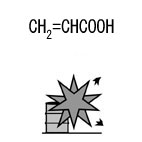| Case Name |
Explosion of an acrylic acid monomer in a drum can during heating due to direct blowing of steam |
| Pictograph |

|
| Date |
February 24, 1981 |
| Place |
Ichihara, Chiba, Japan |
| Location |
Chemical factory |
| Overview |
To prevent solidification of acrylic acid in 200 L drums, an operator started heating. He covered the drums with fireproof sheets, and blew steam onto the drums. After a while, the drums exploded. According to a temperature rise, acrylic acid started polymerization, which led to a runaway reaction.
A heating plate was normally used for indirect heating, but at the time of the accident, the method was changed. It is doubtful whether there were any work manuals for preventing polymerization of an acrylic acid monomer. There is a possibility that the operators did not get education on the hazards of a polymerization reaction of an acrylic acid monomer. |
| Incident |
200 L drums were heated to prevent solidification of an acrylic acid monomer. Polymerization started in the drums. There was a runaway reaction, and the drums exploded. |
| Processing |
Manufacture |
| Individual Process |
Dissolution |
| Substance |
Acrylic acid, Fig2 |
| Type of Accident |
Explosion |
| Sequence |
21:00 on February 24th, 1981, 21:00, Heating started to prevent solidification of an acrylic acid monomer. Two stainless steel 200 L drum cans of an acrylic acid monomer were covered with fireproof sheets, and steam was introduced through a rubber hose.
22:00. The shift changed.
22:30. No trouble was found on checking and heating was continued.
23:36. Internal pressure of one of the drums increased and acrylic acid vapor burst out, the vapor was ignited and exploded. Fire fighting started at once, but after about 10 minutes, the other drum exploded.
23:55. The fire was put out. Poisonous gas hung over within about a radius of 500 meters. The windows of the police office were broken, and a workshop of the factory, and slates and wire glass windows of an adjacent warehouse were also damaged. |
| Cause |
To prevent solidification of an acrylic acid monomer, a heating plate for indirect heating with a built-in steam coil was usually used. On the day of the accident, an employee heated the drums by blowing steam on the drums on his own judgment, and local overheating started a polymerization reaction. Heat of polymerization caused a runaway reaction, which led to an explosion. |
| Response |
When the first 200 L drum exploded, a field operator tried initial fire extinguishing, but failed. Then, a fire fighting team extinguished the fire about 15 minutes later. |
| Knowledge Comment |
Safety measures must be explained with the reasons. |
| Background |
There is a possibility that the employee did not get enough education about the hazards of acrylic acid monomer polymerization, or, there is a possibility that the employee ignored instructions to simplify the work. |
| Sequel |
There are another examples of an acrylic monomer explosion due to local heating as following; on heating 200 L acrylic acid monomer drums, steam piping touched the drums directly and caused local heating, which led to an explosion. |
| Reason for Adding to DB |
Example of explosion caused due to an unusual heating method from an operator's own judgment |
| Scenario |
| Primary Scenario
|
Poor Value Perception, Poor Safety Awareness, Insuficient Education/Training for Safety, Organizational Problems, Poor Management, Slackness of Management, Ignorance, Insufficient Knowledge, Insuficient Study and Experience, Malicious Act, Rule Violation, Safety Rule Violation, Bad Event, Chemical Phenomenon, Abnormal Reaction, Secondary Damage, External Damage, Spouting/Explosion, Loss to Organization, Economic Loss, Manetary Damage 5 million yen
|
|
| Sources |
Fire and Disaster Management Agency, Examples of accidents at manufacturers of dangerous materials, etc. 1981, pp.34-35
|
| Physical Damage |
A workshop, slates, iron doors, wire glass windows of an adjacent warehouse, etc. were damaged. Some windows of Ichihara Police Office, which was 120 meters separate from the site, broke. |
| Financial Cost |
¥ 5 million (Fire and Disaster Management Agency) |
| Multimedia Files |
Fig2.Chemical formula
|
| Field |
Chemicals and Plants
|
| Author |
WADA, Yuji (National Institute of Advanced Industrial Science and Technology)
TAMURA, Masamitsu (Center for Risk Management and Safety Sciences, Yokohama National University)
|
|